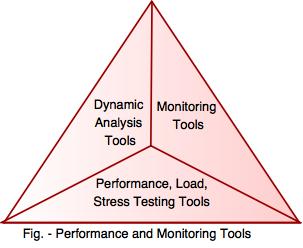Tools for performance and monitoring
Performance and monitoring tools are used during running the tests.
Following are the tools used for performance and monitoring:
i) Dynamic analysis tools
ii) Performance testing, load testing and stress-testing tools
iii) Monitoring tools

i) Dynamic analysis tools
Dynamic analysis tools require the code in running state. Analyzes the code while the software is running.
Features of dynamic analysis tools:
- Find the memory leaks.
- Recognize the errors in pointer arithmetic like null pointers.
ii) Performance testing, load testing and stress-testing tools
- The aim of performance testing is to measure characteristics i.e response times, throughput or the mean time failure. It can be achieved in various ways depending on the tool like different user profiles, different types of activities, timing delays and other parameters.
- Load testing is to check whether the system can handle expected number of transactions.
- Volume testing verifies whether the system can handle the large amount of data.
- Stress testing goes beyond the normal expected usage of the system (load).
Features of performance testing tools:
- Create loads on the system, to be tested.
- Measure the timing of a specific transaction while the load on the system is variable.
- Measure average response time and generate graphs of responses over time.
iii) Monitoring tools
- Monitoring tools track the path of the system status, warning of failures, defects and improve them.
- These tools are used for servers, database, network, security, performance, website, application and internet usage.
Features of monitoring tools:
- Recognize the problems and post an alert message to the administrator.
- Monitor the number of users on a network and the network traffic.
